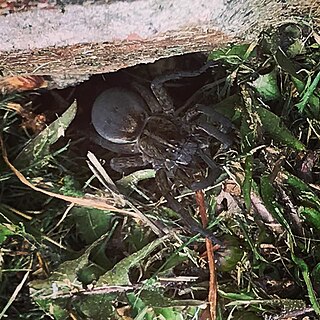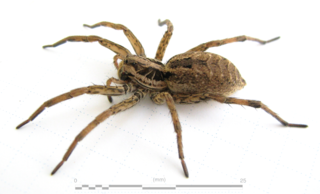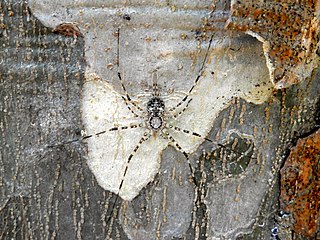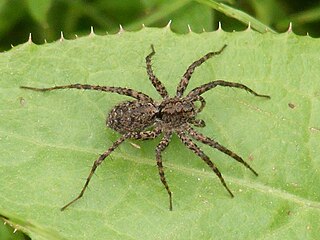
Wolf spiders are members of the family Lycosidae, from the Ancient Greek word "λύκος" meaning "wolf". They are robust and agile hunters with excellent eyesight. They live mostly in solitude and hunt alone, and do not spin webs. Some are opportunistic hunters pouncing upon prey as they find it or even chasing it over short distances. Some wait for passing prey in or near the mouth of a burrow.

The Pholcidae are a family of araneomorph spiders. The family contains over 1,800 pholcids, including those commonly known as the marbled cellar spider , daddy long-legs spider, granddaddy long-legs spider, carpenter spider, daddy long-legger, vibrating spider, gyrating spider, long daddy, and skull spider. The family, first described by Carl Ludwig Koch in 1850, is divided into 94 genera.

Tigrosa aspersa is a large wolf spider that inhabits the eastern United States. Compared to its close relative Tigrosa Helluo, T. aspersa is much larger. This species was known as Hogna aspersa prior to 2012, when the species was moved to Tigrosa.

Hogna is a genus of wolf spiders with more than 200 described species. It is found on all continents except Antarctica.
Hogna ericeticola, known as the rosemary wolf spider, is a species of spider in the family Lycosidae. It is endemic to Florida, in the United States.

Hogna radiata is a species of wolf spider present in South Europe, north Africa and Central Asia. This species is wandering, hunting smaller insects less than 20% of its own size. Found on grass, parks, and forests.
Hogna ingens, the Deserta Grande wolf spider, is a critically endangered spider species endemic to the Deserta Grande Island of the Madeira archipelago - specifically a remote valley, the Vale de Castanheira. Adult numbers have been estimated at less than 5,000, making it one of the rarest wolf spider species. It is also believed to be one of the largest wolf spiders on earth, with a 12 cm (4.7 in) leg span for the female, somewhat smaller for the male. Coloration is grey and black with white spots on the legs. The spider hides under rocks and crevices on this volcanic island, but its habitat is being invaded by the grass Phalaris aquatica, while the native vegetation is damaged by introduced goats and rabbits. The spider preys on smaller relatives, millipedes and other insects, and even small lizards. It is capable of delivering a painful and venomous bite to humans.

Tigrosa helluo is a species of spider belonging to the family Lycosidae, also known as wolf spiders. T. helluo was formerly known as Hogna helluo before differences between dorsal color patterns, habitat preferences, body structures, etc. were discovered. The species is native to the United States, Canada and Mexico. They can be found across the eastern half of the United States, primarily in the northeast and New England, and as far west as Nebraska and Kansas. T. helluo can be found in diverse habitats including woods, marshes, fields, and riparian areas. Typically, members of this species prefer to live in wetter areas as opposed to dry environments. Males tend to live for around a year and females will live for close to two years.
Hogna lupina, is a species of spider of the genus Hogna. It is endemic to Sri Lanka.

Tigrosa is a genus of spiders in the family Lycosidae, found in North America.

Hogna lenta is a species of wolf spider in the family Lycosidae. It is found in the USA.
Hogna baltimoriana is a species of wolf spider in the family Lycosidae. It is found in the USA and Canada.
Diplotaxis frondicola is a species of May beetle or junebug in the family Scarabaeidae. It is found in North America.
Hogna antelucana is a species of wolf spider in the family Lycosidae. It is found in the United States.
Hogna coloradensis is a species of wolf spider in the family Lycosidae. It is found in the United States and Mexico.

Neotama mexicana, also known as the long-spinneret spider or Mexican two-tailed spider, is a species of tree trunk spider in the family Hersiliidae. It is found in a range from the United States to Peru and Guyana.

Pardosa milvina, the shore spider, is a species in the wolf spider family. They are mainly found near rivers and in agricultural areas in eastern North America. P. milvina feed on a large variety of small insects and spiders. Ground beetles such as Scarites quadriceps and large wolf spiders such as Tigrosa helluo are predators of P. milvina. P. milvina are smaller spiders with thin, long legs. This species captures prey such as arthropods with their legs and then kills them with their venom. Their predators are larger wolf spiders and beetles. P. milvina are able to detect these predators from chemotactile and vibratory cues. These spiders lose limbs when escaping from predators and they can change their preferred location in order to avoid predators. P. milvina also use chemical cues in order to mate. During their mating ritual, the male raises his legs and shakes his body. Both males and females can use silk, a chemotactile cue, for sexual communication. Additionally, female shore spiders heavily invest in their offspring, keeping them in egg sacs and carrying them for a few weeks after they are born.
Hogna pseudoceratiola is a species of wolf spider in the genus Hogna of the family Lycosidae. It was described for the first time by Wallace in 1942.










